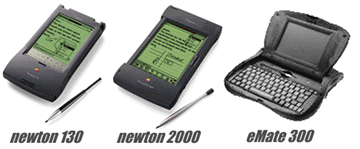![]()

![]()
Apple pioneered the very first PDA in 1993. However, the debut was a flop. But, instead of abandoning the market, Apple worked to improve on the original Newton. It has consistently stayed a leader in the PDA revolution by offering and innovative features over the past three years.
1996 is the culmination of Appleís efforts. This year is a turning point for the Newton. The current model, the Newton 130, boasts highly accurate handwriting recognition, more RAM, and a backlit screen. However, like its predecessors, it is meeting limited success in mass market. To combat this lack of sales, Apple recently announced two new PDAs- the eMate 300 and Newton 2000. These two new models are slated for release in the first quarter of 1997. And, they both hope to solve the PDA problems of Function, Hardware, Input, and Connectivity.
...
Newton 130 The Newton 130 is a middle PDA. It is mainly marketed as a robust personal information manager (PIM) costing approximately $700. Built-in applications include a notepad, money manager, address book, and faxing software. It also has enough power to run third-party add-ons such as simple web browsers, spreadsheets, and databases. This open platform has helped the Newton find niches in vertical markets such as hospitals, delivery services, and art museums. To satisfy this new corporate consumer base, Apple is transforming the Newton into a highly customizable, powerful minicomputer.
Newton 2000 The result of this transformation is the Newton 2000. This device comes pre-installed with PIM software, a word processor, and spreadsheet. In addition, there is also a built-in TCP/IP stack, which opens up a wide range of communications and Internet possibilities. This $1000 PDA looks to make inroads into the laptop market but not dominate it. Thus, it is a middle PDA.
eMate 300 This device is also a middle PDA. However, in comparison to the Newton 2000, the eMate 300 takes a strikingly different approach to the PDA. Instead of being an entry to high-end, corporate market, the eMate is a bold foray in the field of distributed learning. It is the first PDA aimed at schools. The device hopes to provide an inexpensive solution to putting computers directly into the hands of students. Ideally, educators could tailor these eMates with specific curriculums and then issue them to students for learning and studying anywhere and at anytime. Working in conjunction with a schoolís pre-existing desktop computers, these eMates would provide a rich, hi-tech environment for learning. Pricing is unknown at this time.
...
Newton 130
size- 8.0" by 4.0" by 1.2" and 1 lb. (roughly
twice as large as a pants pocket)
screen- average size and resolution, black & white, touchscreen,
non-glare, backlighting
battery- Four AA batteries last approximately 2-3 weeks.
speed- 20 MHz RISC processor (5-7 second wait for application loading)
fragility- only a thin plastic screen lid
Newton 2000
size- 8.3" by 4.7" by 1.1" and 1.5 lb.(roughly
2.5 larger than a pants pocket)
screen- higher than average resolution, and slightly larger screen
than the 130, 16 level greyscale (more shades of gray than standard black
& white), touchscreen, non-glare, backlighting
battery- Four AA batteries will last for 4-5 weeks.
speed- A 160 MHz RISC processor makes the device more powerful than
more desktop computers. Testers at COMDEX 96 claim that the device meets
the PDA ideal of instantaneous response.
fragility- unknown
eMate 300
size- 12.0" by 11.4" by 2.0" and 1 lb. (small
backpack size)
screen- average resolution, greyscale, touchscreen
battery- unknown
speed- 25 MHz RISC processor (Wait time unknown)
fragility- Its peculiar, curvy ergonomics and resilient materials
will make it highly durable. This is essential considering that young children
will be the main users of this product.
For complete technical specifications, please visit the official Apple Newton site, assessible through the Resources page.
...
Newton 130 Ever since the original Newton, Apple has doggedly stood by its philosophy of pen input and handwriting recognition. Thus, Newton 130 can recognize both cursive and printed handwriting and boasts a 93,000 word vocabulary list. Users can make drawings and save them as graphics files. The Apple Newton is also equipped with an onscreen keyboard. In addition, an attachable QWERTY keyboard is offered as accessory.
Newton 2000 The Newton 2000 has the same handwriting recognition architecture as the 130. However, it also adds a microphone for the recording of voice memos.
eMate 300 The eMate mixes a built-in keyboard with pen input. At the time of this writing, it is unknown if it will support handwriting recognition. .
...
Newton 130 This device is has a serial port and a infrared port for information transfer. Desktop synchronization can be achieved through Newton Connection Utilities (NCU) which must be purchased separately. Apple has also recently released the Newton Internet Enabler (NIE). This add-on must be purchased separately and provides the 130 with a TCP/IP stack and modem dialer. Third party support for this standard include several text web browsers, terminal emulators, and e-mail software. The 130 also has one PC Card slot for a modem or wireless communications devices.
Newton 2000 Apple includes the 130ís connectivity options directly into the Newton 2000. The device is bundled with NCU, EnRoute e-mail client, and Nethopper web browser. It comes with a TCP/IP stack which will conform to the standards set by NIE. Newton 2000 also has an infrared port. However, instead of a serial port, it utilizes a InterConnect port which supports serial, LocalTalk, and audio connections. The Newton 2000 is also outfitted with two PC Card slots as opposed to the 130ís one.
eMate 300 The eMate will support all Internet software designed under NIE standards. However, at this time, the eMateís method of desktop computer synchronization is unclear. However, it is vital that these devices be able to interact with schoolsí preexisting infrastructure of desktop computers.